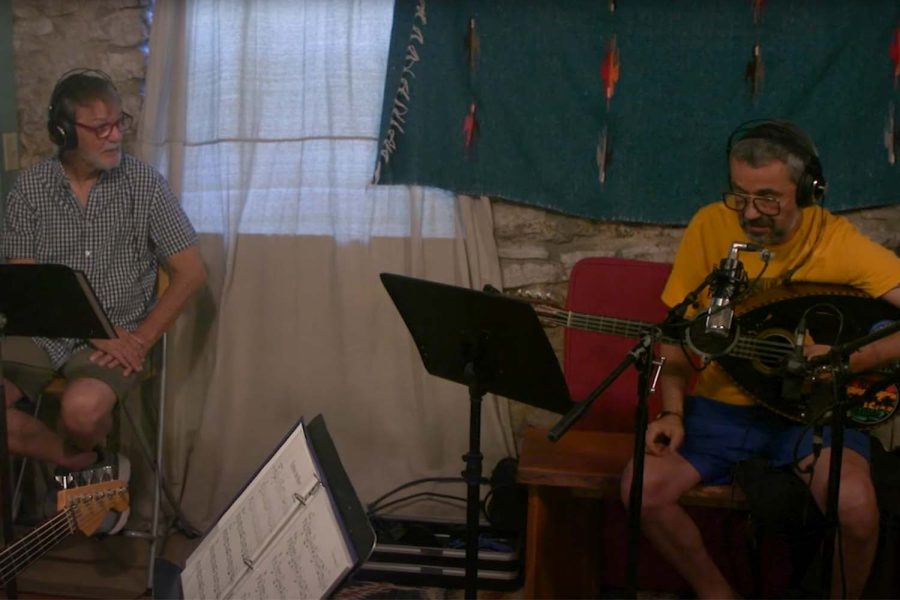Esteban and the Children of the Sun brought lively music, spoken word, and history to The Englert Theatre
Esteban and the Children of the Sun is a multi-media production that tells a story hidden from history at The Englert Theater, the story of Esteban of Azemmour.
Musician Daniel Gaglione asks for adjustments in his in-ear levels during the recording for the album “Esteban” on June 19, 2021.
October 4, 2021
History is often seen through a very specific lens — that of the privileged. Stories are often altered to fit the narrative of those in power, or tales are lost to the unforgiving hand of time. In recent years, these stories have begun to come to light through different artistic mediums.
People lined up on East Washington Street on Sunday afternoon to hear one such story; that of Esteban of Azemmour, a 16th century Moroccan man who was the first documented African man to travel across North American lands.
Esteban and the Children of the Sun was conceptualized by John Rapson, a jazz trombonist and composer who led the UI School of Music Jazz program for 26 years. When Rapson heard about Esteban of Azemmour, he knew that Esteban’s story needed to be told, and wanted to tell it through different artistic media.
When Rapson passed, Trevor Harvey, current director of Htlic media took the role of lead on the project. Harvey was tasked with creating texts and images for the story, detailing Esteban’s story and providing context for the audience. The images were renditions of Esteban throughout history — a man with sharp cheekbones, facial hair, and earrings. The text was presented in a PowerPoint format, with details pulled directly from first-hand accounts, including text from Cabeza de Vaca, one of the travelers on Esteban’s expedition.
The text from de Vaca’s recording of their exploration opened viewers’ eyes to Esteban’s story. To accompany the recount of Esteban in Spain and Spanish colonies, members of Miguel Espinoza’s Flamenco Group played traditional flamenco music.
Viewers learned that Esteban was from Morocco, and in 1527 traveled to North America with his slaveholder. The exploration initially began with 600 men and five ships, and slowly dwindled to 80 men as a result of skirmishes with the Indigenous population, as well as lack of food, water, and shelter. The 80 survivors ended up enslaved by the indigenous population for five years.
After the crowd learns this, Caleb “The Negro Artist” Rainey and Kevin Burt spoke about Esteban being enslaved and then helping them to escape. They provide a contemporary lens to Esteban’s story.
Eventually, nine years after leaving Spain, Esteban and the other men returned to Mexico City. Soon after, Esteban left on another exploration journey as a guide for a Spanish Friar. They traveled for a while with Esteban scouting ahead and acting as a translator until he reached a Zuni pueblo called Hawikuh. From here, the Spanish friar received a report that Esteban had lost his life.
In order to tell this intense story, Rapson recruited different groups including a sensational flamenco group from Denver that brought flair to the stage, the Mektoub Arkestra, Iowa City musician Kevin Burt, spoken-word artist Caleb “The Negro Artist” Rainey, president of Htlic Media Trevor Harvey and countless other groups that contributed behind the scenes.
Rainey comes in at four different points throughout the story to provide commentary on Esteban’s journey in a spoken word format with Kevin Burt. Rainey plays the role of a contemporary Black man commenting on Esteban’s life as someone hearing about it for the first time. To complement the contemporary perspective, Burt plays the role of an elder who is walking Rainey through this new knowledge, including some topics that are tricky to rationalize.
The combination of Burt and Rainey juxtaposed provided a way for viewers to step back and reflect. Their performance was incredibly effective, and their dialogues had goosebumps raising on the arms of audience members.
“We get to have the commentary of why would a slave help his slave masters, and then we get a lovely twist in Esteban’s story in that Esteban’s slave masters also become slaves,” Rainey said. “So, Esteban helps them through slavery, so there’s a complicated feeling there. And of course, you’re talking about two contemporary Black men who have a lot of feelings about that.”
In addition to spoken word and images, Esteban’s story was enhanced by music. The musicians in the story were tasked with creating music in the styles that represented the places found in Esteban’s story. The music was lively and transported the viewer to a different land at a different time. One musician, Tara McGovern, detailed the process that was undertaken in order to honor Esteban’s origins.
“Esteban was Moroccan to begin with. He was enslaved by Spanish Conquistadors, so there’s the flamenco element that weaves in there,” McGovern said. “There’s also a jazz element because our leader John Rapson was a masterful Jazz musician, and we have blues from Kevin Burt where we’re all playing orchestral parts to support him”
McGovern continued to detail how for the production, she plays fiddle. In addition, the show contains a North African mongole performance from Nielo Gaglione.
Ultimately, Esteban and the Children of the Sun is a multimedia production that tells a story that needs telling. While the show has had only one planned performance so far, this past Sunday, the contributors to the show hope to see Esteban and the Children of the Sun as more than a single performance, so that the world can get to know the story of one of the first people from the western world to explore North America, who just so happened to be a Black man.















